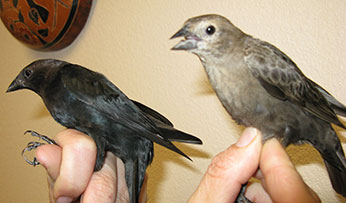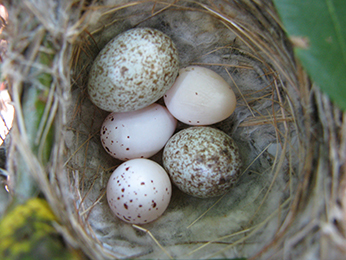(Molothrus ater)
General Description
 Male (L) and female (R) brown-headed cowbirds. Photo by Talula Barbee and Bonnie Johnson Orange County Water District.
Male (L) and female (R) brown-headed cowbirds. Photo by Talula Barbee and Bonnie Johnson Orange County Water District.
 A parasitized least Bell’s vireo (Vireo bellii pusillus) nest containing 3 LBVI eggs and 2 brown-headed cowbird eggs. Riverside County. Photo courtesy of Conan Guard.
A parasitized least Bell’s vireo (Vireo bellii pusillus) nest containing 3 LBVI eggs and 2 brown-headed cowbird eggs. Riverside County. Photo courtesy of Conan Guard.
Brown-headed cowbirds belong to the blackbird family, and can be distinguished from other blackbirds by their smaller size, shorter tail, and thicker head with a stout bill. Brown-headed cowbirds range from 6 to 8.5 inches in length with a wingspan of 12 - 15 inches. Male brown-headed cowbirds have a glossy black body with green iridescence and a dark brown head. Female brown-headed cowbirds have a grayish-brown body, with lighter coloration on the head and underside of the body and brown streaking on the breast. Brown-headed cowbirds are brood parasites; females do not build nests, but rather lay their eggs in the nests of other “host” birds and transfer the responsibility of hatching and raising their young to the “host” bird. Brown-headed cowbirds eggs are white to grayish in color with brown streaking and spots.
Current Distribution
In California, brown-headed cowbirds are a common resident and summer visitor that breed throughout much of the state. They are year-round residents in coastal California and the central valley, with populations present across northern California, the Sierra Nevada, and patches of inland desert regions during the summer breeding season. Their distribution covers the contiguous United States, southern Canada, and Mexico, where migratory populations overwinter.
Habitat Preference
Brown-headed cowbirds are native to the Great Plains region of the United States and prefer open habitats interspersed with shrubs or trees and that provide ample forage and host nests. For foraging, they prefer habitats rich in seeds and invertebrates, such as pastures, fields, meadows, croplands, grasslands, and other areas with short vegetation, and often feed near cattle and other large grazing animals. Brown-headed cowbirds lay their eggs in host nests found in grasslands, trees and shrubs in open woodlands or forest edges, and, to a lesser extent, in sagebrush. Brown-headed cowbirds roost with other cowbirds and blackbirds in the evening near breeding sites.
Pathways
Brown-headed cowbirds originally evolved in a symbiotic relationship with herds of grazing animals, moving throughout the Great Plains region with herds as they kicked up insects for easy foraging. Following the constantly roaming herds, cowbirds couldn’t expend the time for nesting, but rather laid their eggs in host nests as they moved along, leaving host parents to raise their eggs to adulthood. As people began to disperse across North America, clearing forests and expanding domesticated livestock herds and agricultural production, the cowbird range expanded also. Nest parasitism enabled brown-headed cowbirds to quickly establish new populations and expand their distribution across the country.
Impacts
Brown-headed cowbirds parasitize the nests of more than 220 bird species in their range. Each cowbird can lay up to 30 eggs per season and usually lay 1 or 2 (or occasionally more) eggs in each host nest. When parasitizing nests, they often remove the egg(s) of the host bird. Brown-headed cowbird chicks usually hatch sooner than the host chicks, are larger, and develop faster. Their larger size and persistent behavior gains them more care from the host parents. Nest parasitism lowers the reproductive success of host birds and has led to population declines in several bird species. In California, the riparian songbirds least Bell’s vireo (Vireo bellii pusillus) and willow flycatcher (Empidonax traillii) are listed as endangered due to loss of riparian habitat and nest parasitism by brown-headed cowbirds.
Actions Taken if Found
If you observe this species in California, please report your sighting to the CDFW Invasive Species Program, by email to Invasives@wildlife.ca.gov, or by calling (866) 440-9530.